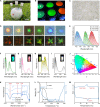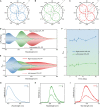Processable circularly polarized luminescence material enables flexible stereoscopic 3D imaging
- PMID: 37878702
- PMCID: PMC10599622
- DOI: 10.1126/sciadv.adi9944
Processable circularly polarized luminescence material enables flexible stereoscopic 3D imaging
Abstract
Endowing three-dimensional (3D) displays with flexibility drives innovation in the next-generation wearable and smart electronic technology. Printing circularly polarized luminescence (CPL) materials on stretchable panels gives the chance to build desired flexible stereoscopic displays: CPL provides unusual optical rotation characteristics to achieve the considerable contrast ratio and wide viewing angle. However, the lack of printable, intense circularly polarized optical materials suitable for flexible processing hinders the implementation of flexible 3D devices. Here, we report a controllable and macroscopic production of printable CPL-active photonic paints using a designed confining helical co-assembly strategy, achieving a maximum luminescence dissymmetry factor (glum) value of 1.6. We print customized graphics and meter-long luminous coatings with these paints on a range of substates such as polypropylene, cotton fabric, and polyester fabric. We then demonstrate a flexible textile 3D display panel with two printed sets of pixel arrays based on the orthogonal CPL emission, which lays an efficient framework for future intelligent displays and clothing.
Figures





References
-
- E. Downing, L. Hesselink, J. Ralston, R. Macfarlane, A three-color, solid-state, three-dimensional display. Science 273, 1185–1189 (1996).
-
- D. Fattal, Z. Peng, T. Tran, S. Vo, M. Fiorentino, J. Brug, R. G. Beausoleil, A multi-directional backlight for a wide-angle, glasses-free three-dimensional display. Nature 495, 348–351 (2013). - PubMed
-
- H. Yu, K. Lee, J. Park, Y. Park, Ultrahigh-definition dynamic 3D holographic display by active control of volume speckle fields. Nat. Photon. 11, 186–192 (2017).
-
- D. D. Zhang, T. Y. Huang, L. Duan, Emerging self-emissive technologies for flexible displays. Adv. Mater. 32, 1902391 (2020). - PubMed
-
- X. Shi, Y. Zuo, P. Zhai, J. Shen, Y. Yang, Z. Gao, M. Liao, J. Wu, J. Wang, X. Xu, Q. Tong, B. Zhang, B. Wang, X. Sun, L. Zhang, Q. Pei, D. Jin, P. Chen, H. Peng, Large-area display textiles integrated with functional systems. Nature 591, 240–245 (2021). - PubMed
LinkOut - more resources
Full Text Sources
Miscellaneous

